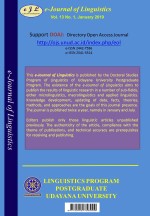A Morphosyntactical Analysis of University Students’ Writing: Indonesian Case
Abstract
Different grammar between languages often causes confusion to those who learn it. Students often experience such problems when their first language (L1) and the target language (L2) share very limited linguistic aspects. This study aims to focus on the morphosyntactic issues that lead to the grammatical errors which take place in the English writing of Indonesian university students taking writing class and to analyze the potential sources of their mistakes. The data from this study were collected from a writing assignment in three Writing classes. This research followed the steps initiated by James (1998), among others: collecting data, identifying errors, classifying errors, explaining errors, and finding sources of errors. The results revealed that of the 2.218 grammatical errors found, they could be classified into two main error types: morphological errors (81.97%) and syntactic errors (18.03%) which were divided into 32 specific errors. The findings suggest that the Indonesian students are not fully aware how to use the plural marker ‘s’ as well the ‘3rd singular’ in present tense. Moreover, they cannot build a simple sentence due to the different word-order and sentence structure between Indonesian and English in terms of morphology and syntax.With regard to the potential sources of error, both inter-language errors and intralingual errors and developments have an influence on errors made in writing. Errors between languages occur when students try to use their knowledge of the L1 structure to obtain the target language, but the differences between the two languages cause errors. Intralingual and developmental errors are found because of difficulties and problems in the target language itself. The findings in this study are very useful for the process of learning English especially in writing skills.
Downloads
References
Ally. 2014. What Adult ESL Learners Say About Improving Grammar and Vocabulary in Their Writing in Their Writing for Academic Purposes. Routledge.18:1, 31-46, DOI: 10.1080/09658410802307923
Brown, H. D. (2000). Principles of Language Learning and Teaching (4th ed.). New York, NY:Pearson Education.
Corder, S. P. (1981). Error Analysis and Interlanguage. Oxford: Oxford University Press.
Dulay, H. W., Burt, M., & Krashen, S. (1982). Language Two. New York, NY: Oxford University Press.
Fiona. 2015. Why do Linguistic. UK: Bloomsbury publishing
Hariri, M. (2012). Taxonomy of Morpho-syntactic Errors and ErrorAnalysis. Research Journal of Applied Sciences, Engineering andTechnology, 4(22): 4856-4860.
Hermas. 2014. L1 Morphosyntax in L3 English. International Journal of Universite du Quebec A Montreal language studies).
James, C. (1998). Errors in Language Learning and Use. London: Longman
Lado, R. (1971). Linguistic Across Culture. Ann Arbor, Michigan: University of Michigan Press.
Myles, J. (2002). Second Language Writing and Research: the Writing Process and Error Analysis in Student Texts. TESL-EJ, 6(2). Retrieved from:http://tesl- ej.org/ej22/a1.html
Richards, J. C. (1974). Error Analysis: Perspectives on Second Language Acquisition. London: Longman.
Richards, J. C., & Renandya, W. A. (2002). Methodology in Language Teaching: AnAnthology of Current Practice. Cambridge: Cambridge University Press.
Santos ,T. by Atkinson. 2015. The Role of Grammar in TESL and Composition. In J. Frodesen & C.Holten (Eds), The power of context in language teaching and learning (pp.153-162). Boston: Heinle.
Susan. 2016. Second Language Acquisition and applied Linguistics. New York: Rotledge

This work is licensed under a Creative Commons Attribution 4.0 International License











